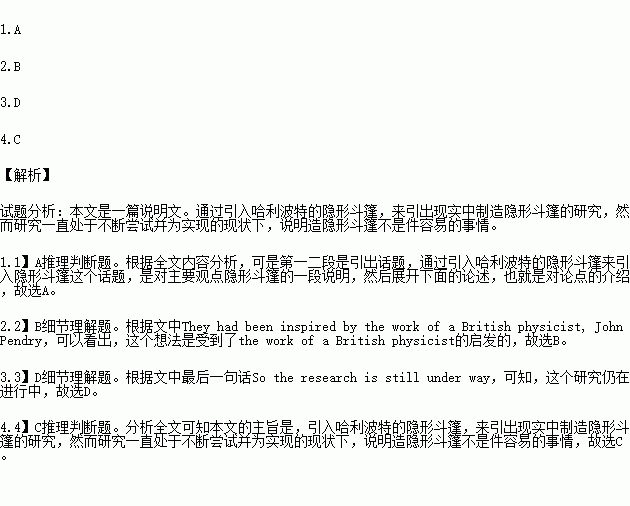题目内容
Imagine what you could do with a machine that could make things disappear.
For inspiration, you could read some books. In the books of J.R.R. Tolkein, Bilbo Baggins finds a ring that can make him disappear. Of course, there’s also poor Harry Potter, who used his invisibility cloak (隐形斗篷) to hide from danger.
Now that you’ve got some ideas, it’s time for the hard part: building the cloak. To do that, you have to give up science fiction and turn to real science. An invisibility cloak has to cheat anything or anyone who might be watching. In order to understand how something can be seen, it’s important to understand how we see.
Human beings can only see objects that reflect (反射) light waves. These waves enter the eye and are then processed by the brain. However, if an object doesn’t reflect light, then the waves don’t enter the eye, and the brain doesn’t process. So building an invisibility cloak is building something that doesn’t reflect light.
Cummer was part of a team of scientists from Duke University, including David Smith and David Schurig, who built the world’s first version (版本) of an invisibility cloak. They had been inspired by the work of a British physicist, John Pendry. He in May said that an invisibility cloak was possible and Pendry was not the only one thinking about a disappearing act. At the same time, a Scottish physicist, UIf Leonhardt published a paper on building invisibility equipment.
“It wasn’t easy,” says Cummer. “As often happens in science and research, it didn’t work very well the first time. That first cloak didn’t work like Harry Potter’s --- the scientists didn’t actually see anything disappear. So the research is still under way. ”
1.The first two paragraphs serve as a (n) ________.
A. introduction B. explanation
C. comment D. summary
2.Cummer and other scientists got the idea of building an invisibility cloak from _________.
A. the film Harry Potter
B. the work of a British physicist
C. a paper published by a Scottish physicist
D. the book of J.R.R. Tolkein
3. From the text we learn that the research on an invisibility cloak __________.
A. was led by Pendry
B. was very successful
C. was used in most popular movies
D. is still in progress
4.What can be the best title for the text?
A. The Science of Disappearing
B. The Hardest Part of Building a Cloak
C. The Invention of an Invisibility Cloak
D. Turn Science Fiction into Real Science
 快乐暑假暑假能力自测中西书局系列答案
快乐暑假暑假能力自测中西书局系列答案
